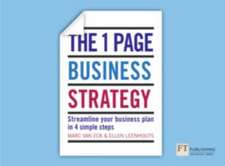The 5 Laws of Innovation Success: Generating Critical Momentum for Products, Services and Ideas
Autor G. Douglas Olsenen Limba Engleză Paperback – 30 iun 2011
Preț: 107.08 lei
Nou
Puncte Express: 161
Preț estimativ în valută:
20.49€ • 21.32$ • 16.92£
20.49€ • 21.32$ • 16.92£
Carte disponibilă
Livrare economică 24 martie-07 aprilie
Preluare comenzi: 021 569.72.76
Specificații
ISBN-13: 9780615465654
ISBN-10: 061546565X
Pagini: 270
Dimensiuni: 152 x 229 x 15 mm
Greutate: 0.4 kg
Editura: Novetics Press
ISBN-10: 061546565X
Pagini: 270
Dimensiuni: 152 x 229 x 15 mm
Greutate: 0.4 kg
Editura: Novetics Press








